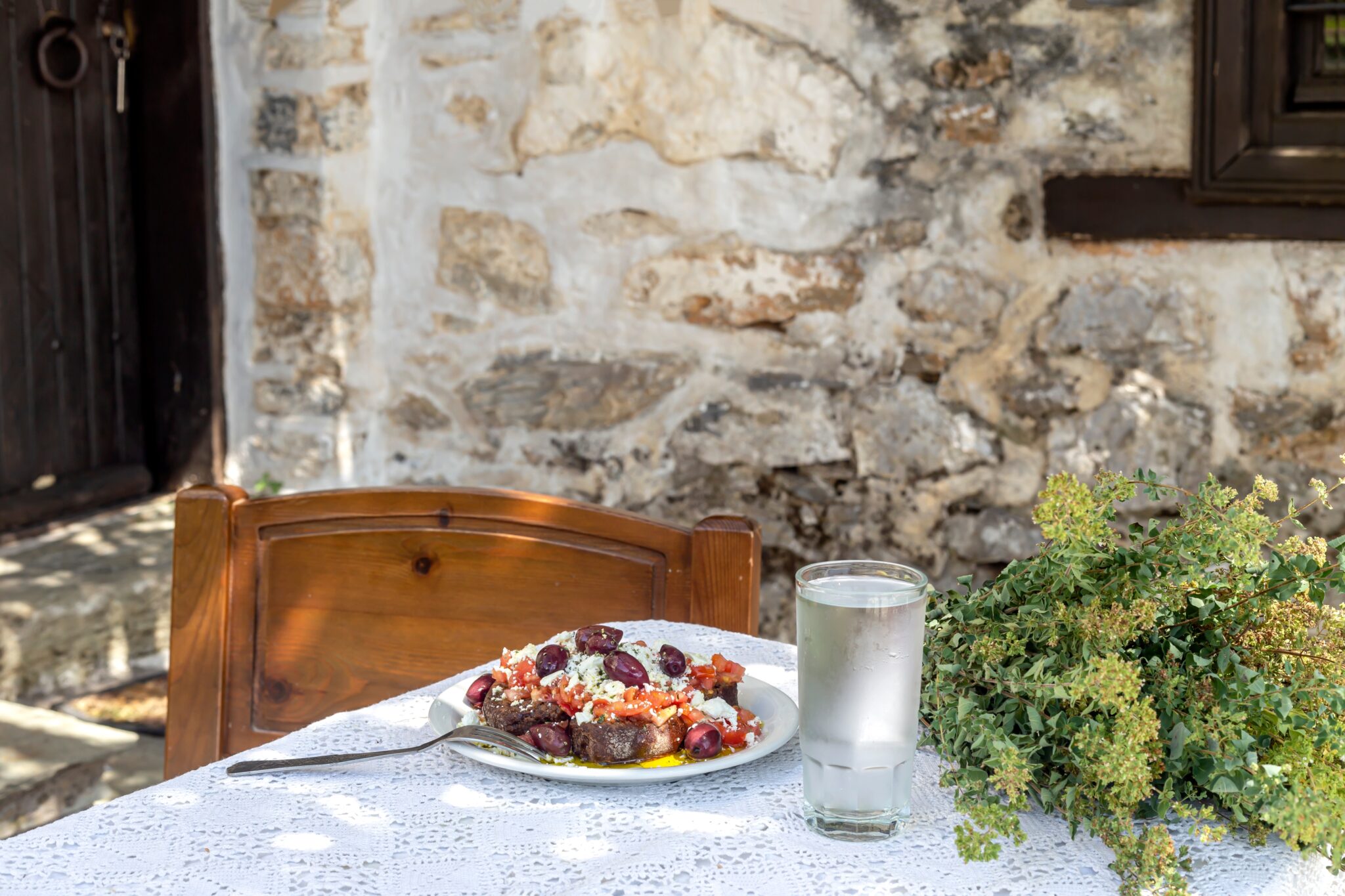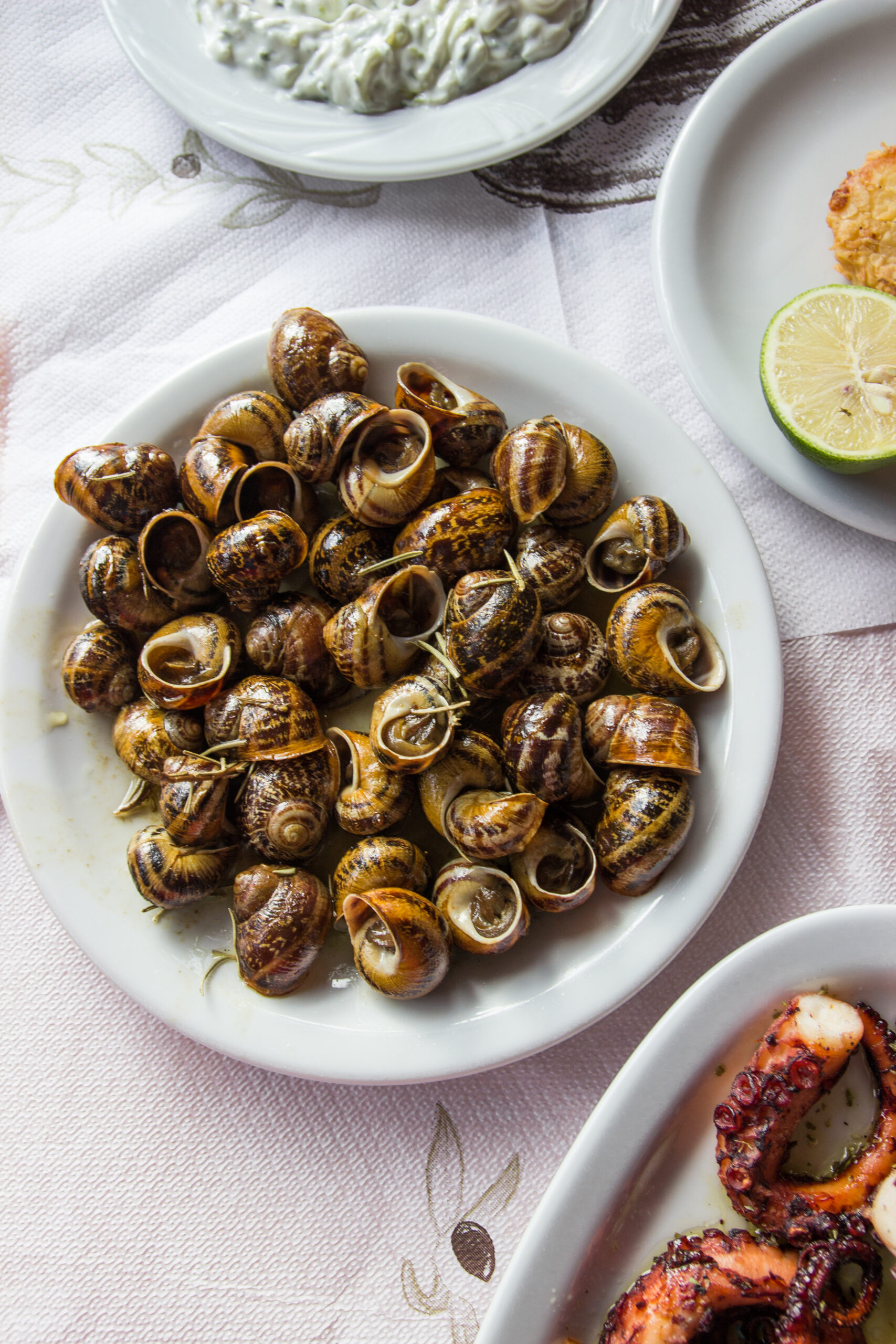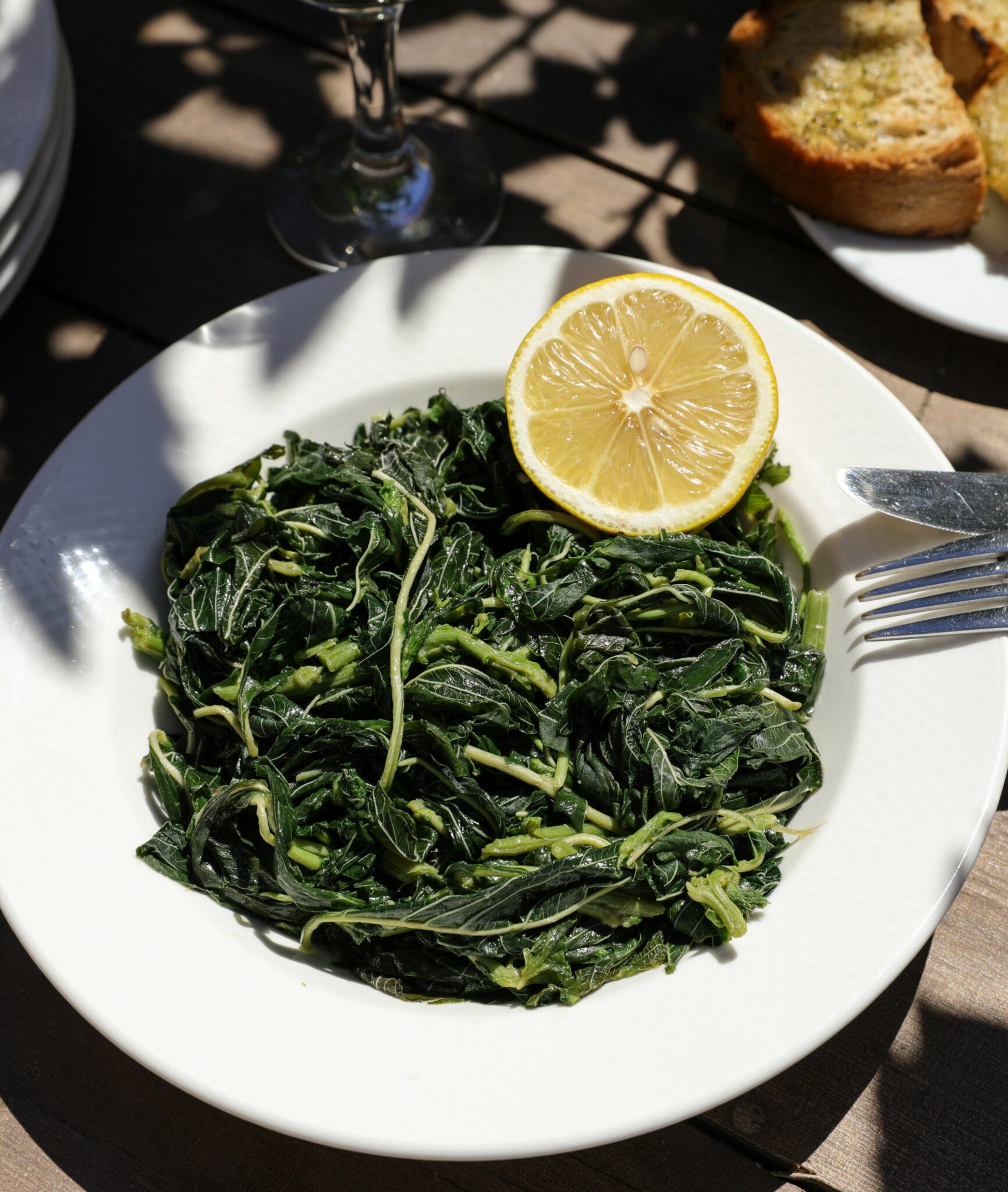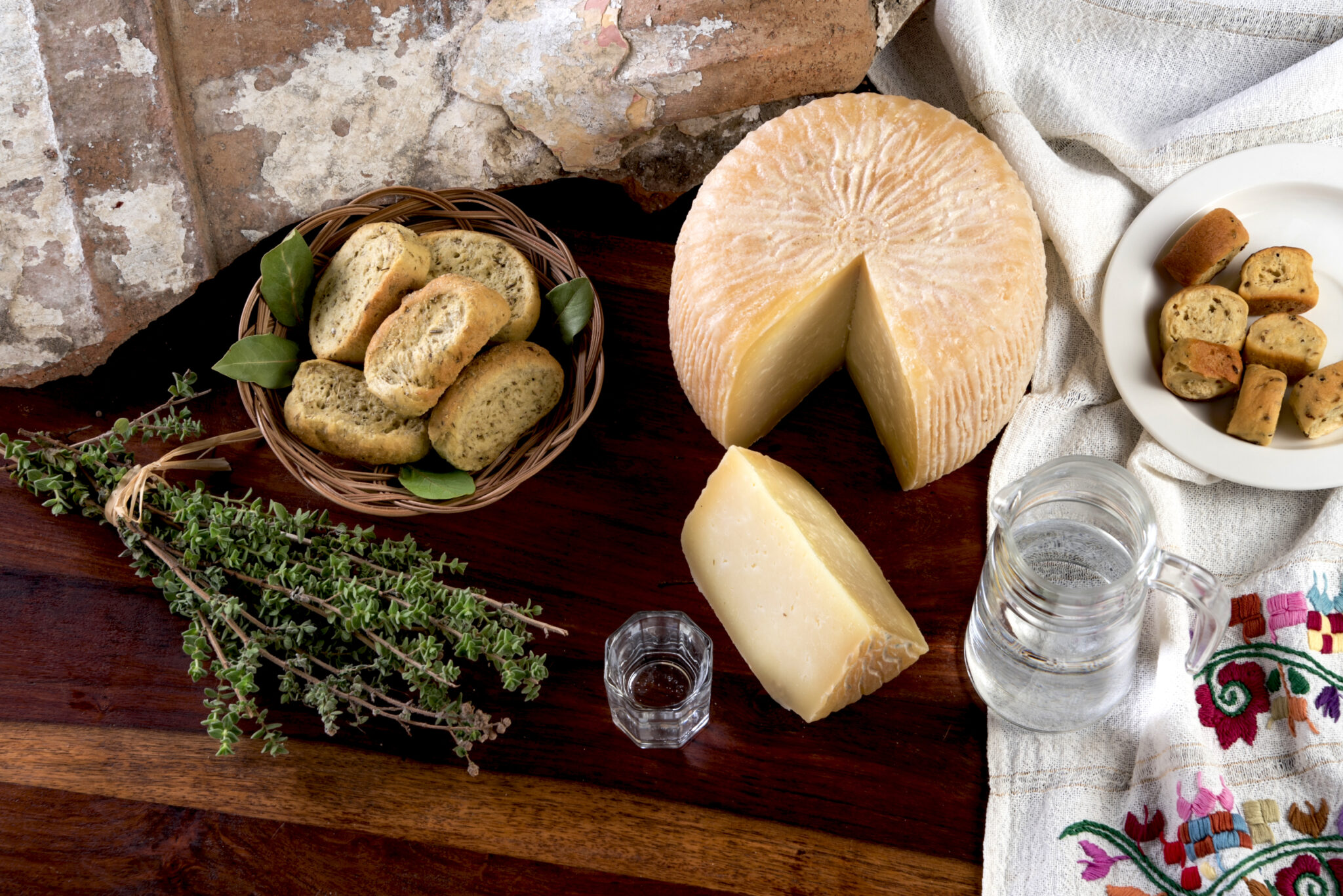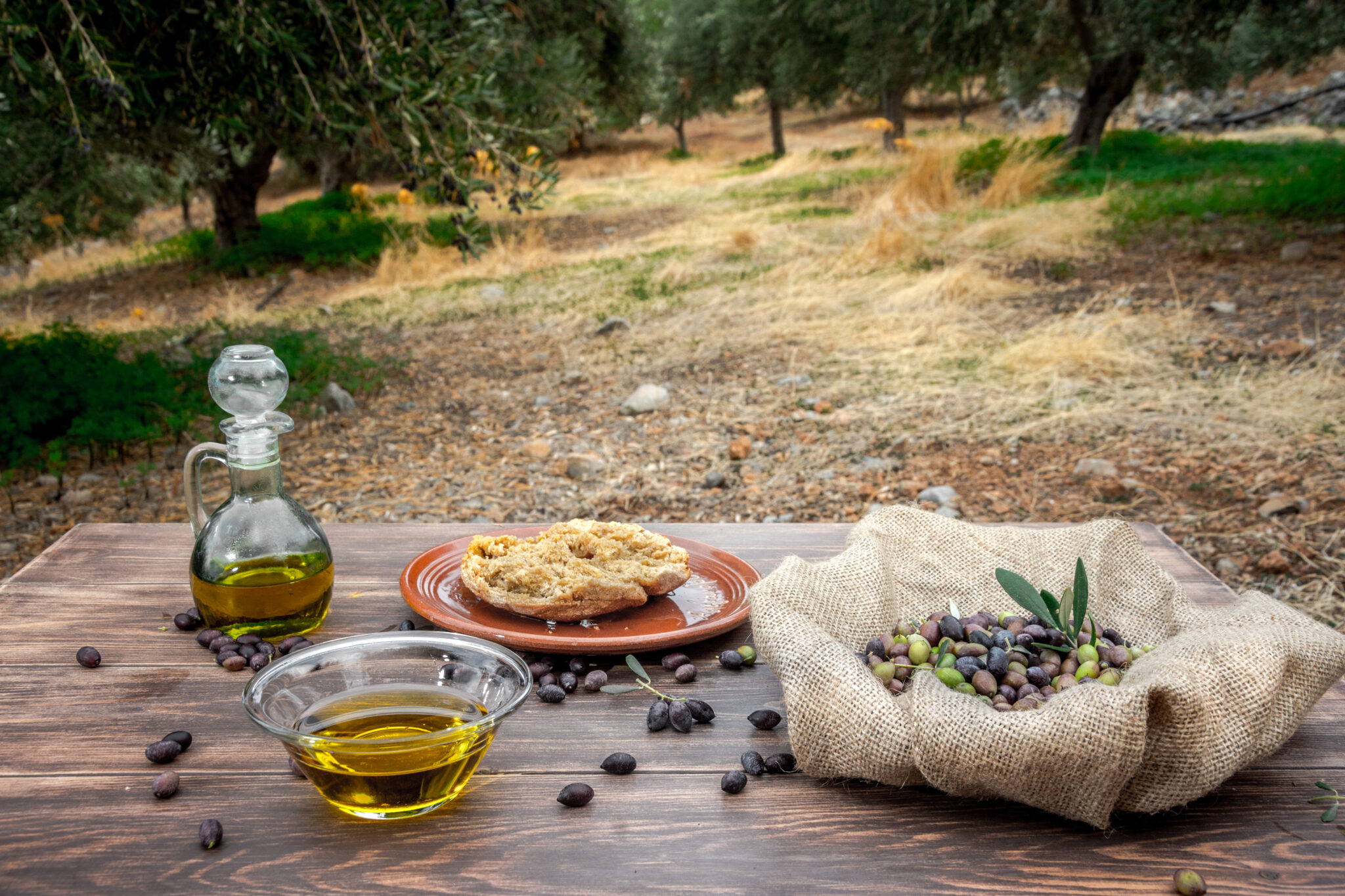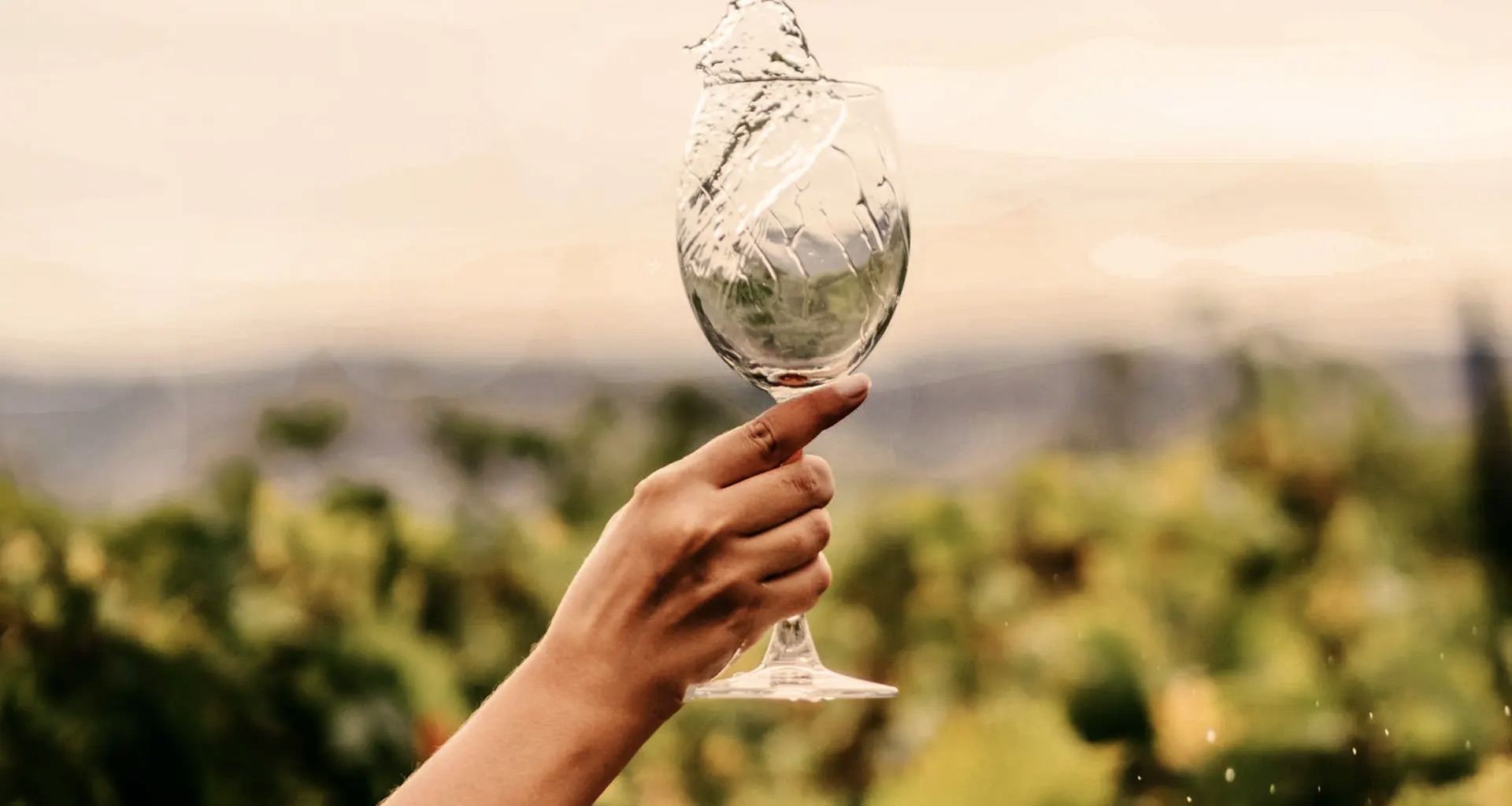Barren mountain ranges, kilometres of unique beaches, fertile plains, a rural lifestyle, and a city with centuries of urban consciousness; from Sfakia to Kissamos and from the North Axis to the South, Chania boasts a rich gastronomic heritage, with many aspects, different habits, various culinary styles and beloved ingredients.
In the very city of Chania, with its vibrant market and lively urban order, a cuisine developed, influenced in part by the lengthy Venetian rule, featuring more refined, elaborate dishes, such as the Easter meat pie or the summer ‘boureki’ filled with the sweetest courgettes and Chania cheeses.
Amid the sophisticated city recipes, the hearty Chania stew, known as ‘tsigariasto arni’ or ‘rifaki’, holds its own. This dish, originally a shepherd’s meal, is made simply with salt and a dash of olive oil, using the juices from the meat, and prepared in the mountains and valleys. ‘Gamopilafo’, a festive boiled dish made by using primarily the meat of larger animals and chicken to create a rich broth in which a pilaf is cooked, is a dish that is famously known throughout Greece and popularly served at wedding celebrations. The frying pan plays a pivotal role in Cretan cooking, as a lack of trees made cooking in the wood-burning oven a challenge. This led to more slow cooking over small sticks on the hearth, using a pan or pot. Here, chicken and rabbit or potatoes and eggs were fried quickly upon the arrival of unexpected guests.
The wild greens that the earth delivers with the winter rainfall and cold climate are cooked with meat in fricassee dishes, folded into pies, made into salads, stewed, and added to omelettes. Wild mushrooms, fried in flour or even stewed along with snails, offer exceptional, high-quality, and economical protein. Staka and stakovoutiro, quintessential Chania dairy products, made by concentrating butter in milk, add a delicious depth to fried eggs and pilaf when the boiled meat is not quite rich enough in itself.
The region’s cookbook would be incomplete without its oil-based dishes, fresh vegetables and legumes. Among the most cherished summer dishes, dolmades and stuffed blossoms with rice and mint are served with a side of yoghurt. The cool, tart yoghurt offers a refreshing contrast to the sweetness of the rice. In the realm of pies, we absolutely must mention the now-famous Sfakia pie. The paper-thin dough is filled with fresh sour mizithra cheese and briefly cooked in a pan without any fat.
Kastelians are the ones who traditionally specialise in seafood cuisine, as they’ve been fishing off the coast of Gramvousa for generations.
Recipies from Chania
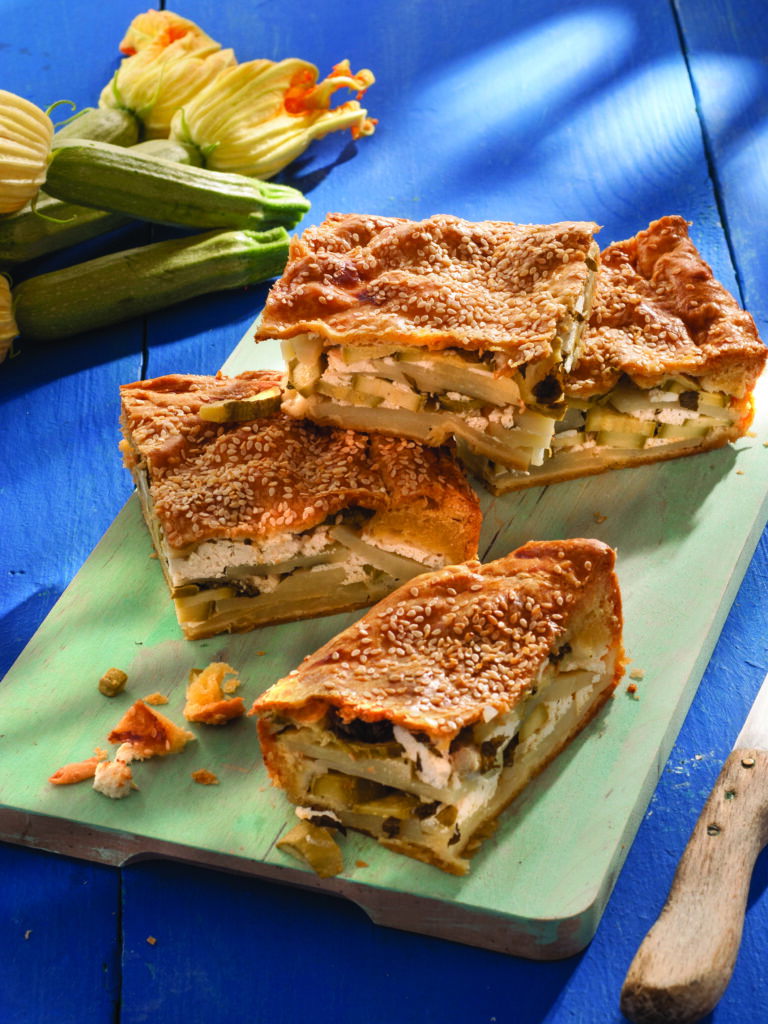
Boureki from Chania
The first boureki in Crete was introduced by the Turks, around 1674, but this particular recipe, the courgette börek, is a delicacy from Chania and remains a staple of a worthy cook to this day.
For one oven tray (8-10 people)
Preparation: 30 mins, Baking: 1 hour + 30 mins-2 hours
Cost: €1.50 per serving
Ingredients
For the pastry dough
1 glass of water
½ teaspoon salt
1/3 glass of extra virgin olive oil
1 shot of raki
1-2 tablespoons of lemon juice
½ kilogram all-purpose flour
For the filling
3-4 potatoes, thinly sliced
4-5 courgettes, thinly sliced
150 grams of stakovoutyro (Cretan butter)
½ bunch of fresh mint, finely chopped
½ glass of extra virgin olive oil
350 grams of xinomizithra cheese (a sour variant of mizithra cheese)
1 egg
Some sesame for sprinkling
Procedure
Dough: In a bowl, combine all the ingredients and mix well with your hands. Knead until you get a soft and pliable dough. Cover with a cotton cloth and set aside to rest for 30 minutes. Divide the dough into two large balls.
Filling- Assembly: Salt the potatoes and courgettes well and place them in a colander for 10-15 minutes to drain. Preheat the oven to 175°C (on resistances). Use some stakovoutyro to grease a large oven tray on the bottom and the sides. On a floured workbench, with a thin rolling pin, roll out one dough ball into a sheet that covers the bottom and sides of the tray and place it in the tray. On top, spread half the potatoes, drizzle with ¼ of the oil, spread ¼ of the xinomizithra cheese, and some stakovoutyro. Next, arrange the courgettes, pour over another ¼ of the oil, spread another ¼ of the xinomizithra, some more stakovoutyro, and sprinkle with half the mint. Repeat the process.
On a floured workbench, with a thin rolling pin, roll out the other dough ball into a round sheet that covers the surface of the pie. Cover the pie with the second sheet and join the edges of the bottom sheet with the top by pressing with your fingers and slightly rolling towards the inside. In a small bowl, beat the egg with a fork and use a brush to glaze the surface of the pie. Sprinkle with sesame and bake for 1½-2 hours. Change the oven setting to fan and bake for another 10 minutes until the pie is well browned.
Tips
To uniformly roll out the pastry, make sure to change the side and direction after each roll, and when you fold the pastry onto the rolling pin, push with your palms from the centre towards the edges, continuing to roll.
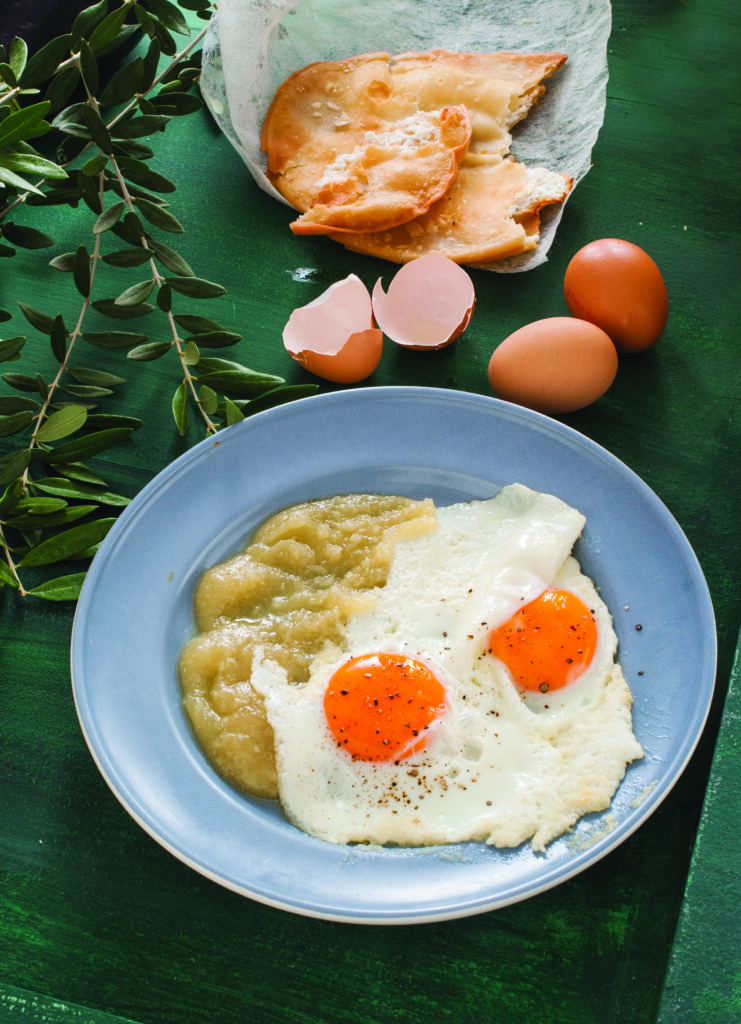
Eggs with Staka
This is a Chaniotiko meze (a dish from Chania, Crete), boasting great flavour, which has now started being served in other regions too.
Serves 4
Preparation: 5 minutes, frying time: 15 minutes
Cost: €1 per portion
Ingredients
8 tablespoons of staka
8 eggs
5½ tablespoons of flour
Salt and pepper
Procedure
In a frying pan, warm half of the staka over medium heat for 2-3 minutes until it melts, and then add the eggs. Fry them for 3-4 minutes, continually basting with the staka until the egg whites set. Then transfer the eggs to a plate and season with salt and pepper. Lower the heat (from medium to low) and add the remaining staka to the pan, leaving it for 2-3 minutes to melt and then adding the flour. Stir for another 4-5 minutes until a roux is formed. Season well with salt and pepper and serve the roux immediately along with the eggs.
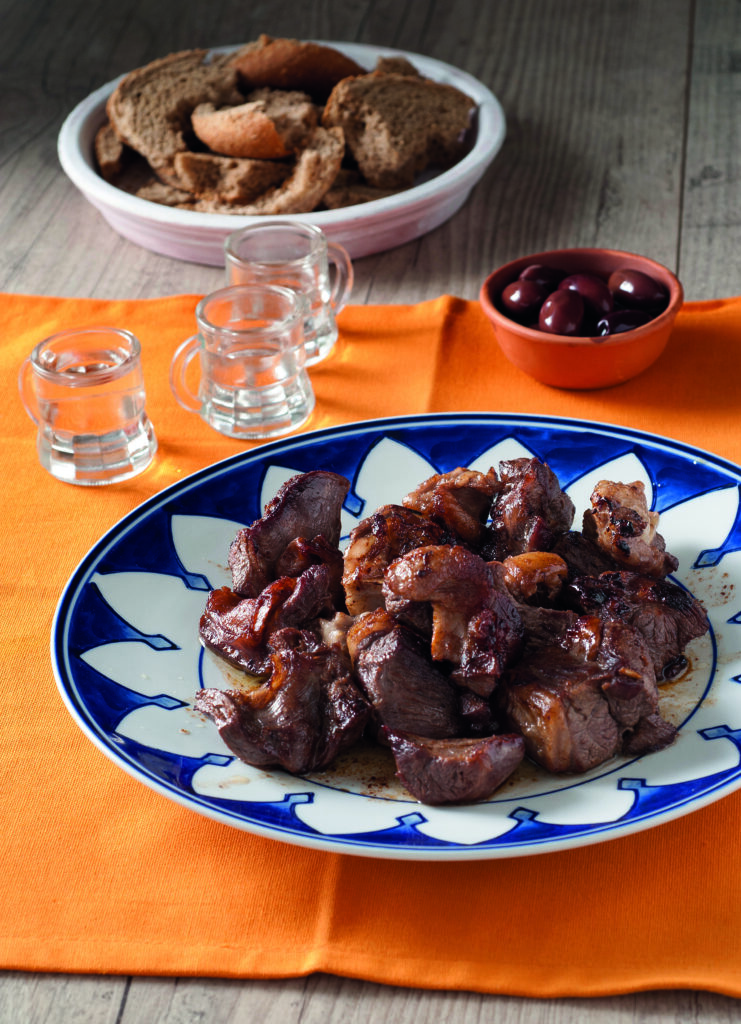
Sfakiano Tsigaristo (with lamb or goat)
This is a dish from the secluded livestock regions of Western Crete. Traditionally, it was made with only two ingredients, meat and olive oil.
Serves 4
Preparation: 15 minutes, Cooking: 2 hours + 20 minutes
Ingredients
1½ kg of lamb or goat meat (from the leg), cut into pieces
½ cup extra virgin olive oil
1 cup of dry red wine
Salt & pepper
Procedure
Wash the meat and season it well with salt and pepper. In a wide pot, heat the oil over high heat and sauté the meat, stirring continuously with a wooden spoon for 5-7 minutes, until it is browned. Add the wine and let it evaporate for 1-2 minutes. Then lower the heat (from high to low), cover the pot, and let it simmer for 1½-2 hours until the meat is well-cooked and tender. When it is ready, increase the heat again (from low to high), stirring continuously for 5-10 minutes, until the liquids have evaporated, the meat is reddish and has “tsigaristo” (sautéed).
Tips
The term “tsigaristo” implies that after cooking, when all the liquids have evaporated, the meat is sautéed in its own fat. Traditionally, tsigaristo was made with a freshly slaughtered small animal and cooked only in its own juices. Today, as the meat is purchased and therefore drier, liquids are needed for cooking, so we add either wine or water. If you use red wine, it should be light, without tannins, or alternatively choose a rosé.
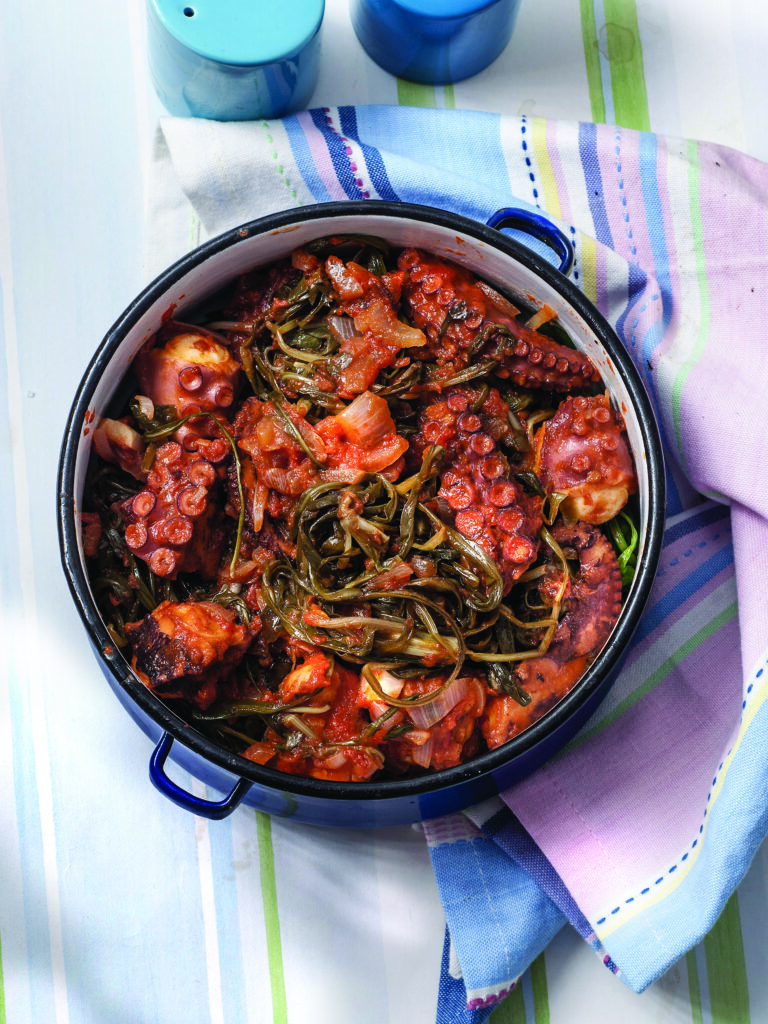
Octopus with Dandelion Greens
Wild dandelion greens in their prime, found is in February and March, are bitter, aromatic, and crisp, and quite challenging to gather. The variety found throughout the year is cultivated, with a significantly less intense flavour and larger leaves, resembling a simple radish.
Serves 4
Preparation Time: 15 minutes
Cooking Time: 50 minutes
Ingredients
1 medium-sized octopus (approximately 1.5 kg)
½ cup of extra virgin olive oil
1 onion, roughly chopped
1 garlic clove, sliced
2 large tomatoes, finely chopped
1 teaspoon of tomato paste
1 cup of dry white wine
2 bay leaves
500 g dandelion greens, cleaned and washed
Salt & pepper
Procedure
Pour a cup of water and the octopus into a large pot. Cover with the lid and simmer over a low heat for 30-40 minutes until it becomes tender. Move the octopus to a plate and let it cool for 10 minutes. Retain the juices in a bowl. Using a sharp knife, cut the octopus into small pieces.
In the same pot, heat the oil over high heat and sauté the onion for 2-3 minutes. Add the garlic and continue to sauté for another minute. Incorporate the tomatoes, tomato paste, wine, bay leaves, liquid from the octopus, salt, and pepper. Stir with a wooden spoon and as soon as it reaches a boil, add the octopus and dandelion greens.
Cover the pot, reduce the heat (from high to medium), and simmer for another 10 minutes, until the dandelion greens have softened. It can be served hot, warm, or cold.
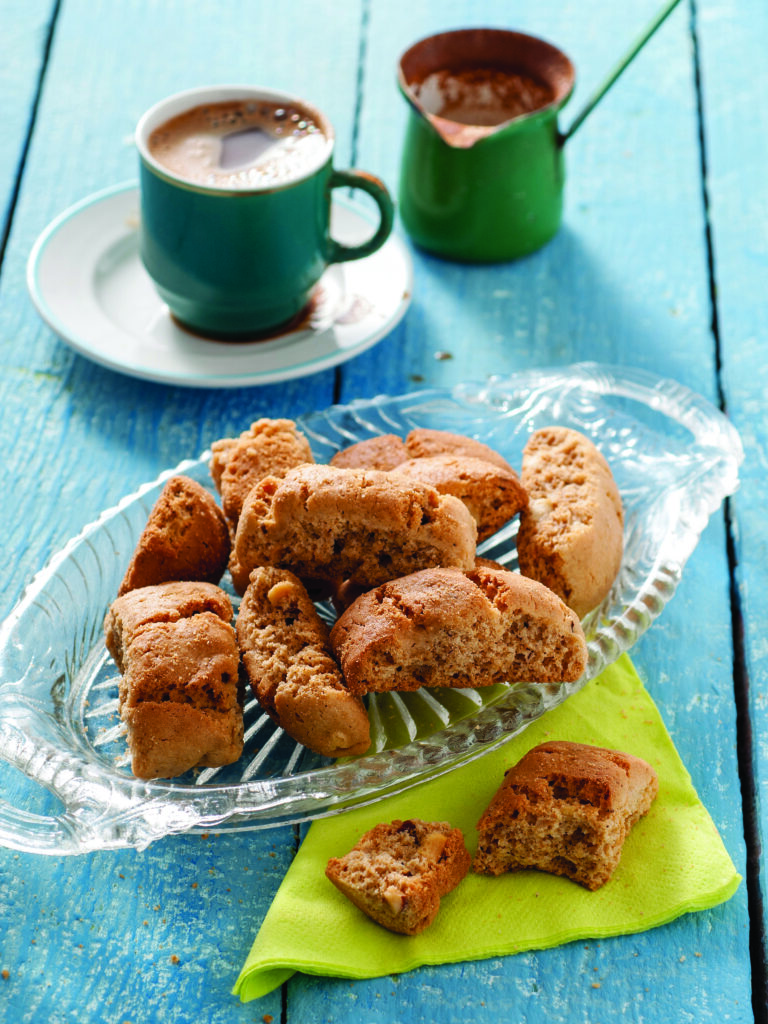
Good Luck Sesame Cookies
Almond-filled pastries, in a recipe dating back to medieval times, are called “kalorizika” because they were offered as good luck treats at weddings or births for good luck (“kaloriziko” meaning good fortune).
Yield: Approximately 1 kg
Preparation Time: 20 minutes
Baking Time: 23 minutes
Resting Time: 1 hour
Ingredients
125 ml extra virgin olive oil
160 ml sunflower oil
170 g granulated sugar
Zest of 1 unwaxed orange
150 ml orange juice
½ shot of raki (anise-flavored spirit)
¼ tsp baking soda
½ tsp cinnamon
¼ tsp cloves
2-3 drops of bitter almond extract (optional)
625 g self-rising flour
100 g almonds, coarsely ground with the skins
Procedure
Preheat the oven to 180°C (fan-assisted). In a bowl, combine the oils and sugar, mixing well by hand or using a whisk. Add the orange zest, orange juice, raki, baking soda, cinnamon, cloves, and bitter almond extract (if using). Continue stirring until all the ingredients are fully incorporated.
Gradually add the flour while kneading with your hand until a soft and elastic dough forms. Incorporate the ground almonds and continue kneading for a little longer. (If the dough seems slightly sticky, do not add additional flour. When you need to shape it, lightly oil your hands).
Line two baking trays with non-stick parchment paper. Divide the dough into four equal portions and shape them into four elongated fringed pastries (35 x 5 cm each). Ensure they are uniform and puffy, without pressing down too much on the top, as they will spread during baking. Place two pastries on each tray. Using a sharp knife, lightly score each pastry (to a depth of 0.5 cm).
Bake for 15 minutes. Remove from the oven and, using a knife, separate the fringed sections into small pieces along the scored lines. Bake for another 8 minutes. Allow them to cool for 15-20 minutes. Remove the cookies from the trays and let them cool for at least 1 hour.
Tips
The dough may slightly stick to your hands, but avoid adding more flour as it may result in dense and hard cookies. Store the kalorizika in a tightly sealed container or metal tin for several days in a dry and cool place.
Chania Raw Materials
In the prefecture of Chania, livestock farming and dairy production are primary occupations that reflect a long-standing tradition, high reputation, and exceptional quality. Among Chania’s most distinguished dairy products are the P.D.O Graviera of Crete (a sheep and goat milk cheese matured for at least three months), the P.D.O Xinomizithra of Crete (a fresh soft cheese made from sheep and goat whey with added milk), the P.D.O Pichtogalo of Chania (fresh, soft cheese with a creamy texture and a slightly sour taste, made from full-fat sheep and goat milk), the kefalotyri (made from sheep and goat milk), the dry anthotyro (a dry cheese made from sheep and goat whey with added fresh milk), and staka, as well as new generation Graviera cheeses with herbs, spices, and aromatic plants.
On morphologically distinctive land, the vineyards of Chania span more than 3.7 acres and are mostly spread along the northern coast, with the best of them on the northern slopes of the White Mountains. Approximately 80% of these are covered by the Romeiko grape variety, which forms the basis for the locally popular Marouvas wine. This is a unique red wine, high in alcohol content, with a distinct oxidised character and aromas reminiscent of cognac. The ageing process of this wine resembles an early form of the solera system used for Spanish sherry. The prefecture boasts two Protected Designation of Origin titles, Chania and Kissamos.
In vine cultivation, we must not forget the PGI Sultanina Raisins of Crete, the grapes of which, when not consumed as table fruit, are used for distilling the sweetly potent tsikoudia (raki).
Olive cultivation has always been widespread, but today varieties such as koroneiki and tsounati yield the exceptional Kolymvari Chania Crete PDO extra virgin olive oil and the Chania PGI extra virgin olive oil. The succulent, aromatic Maleme oranges, also suitable for juicing, have gained PDO recognition. The honey produced by summer bees is exceptional, and the pine-thyme honey has been recognised as Crete PDO.
Avocado plantations have thrived in the region for over six decades, and mangoes have acclimatised well with the fruit already being exported.
In the mountains and ravines, numerous flocks of near-wild lambs and goats roam, especially in the winter and spring months when vegetation is plentiful. Among the breeds favoured by farmers, we find the primitive Sfakia breed of sheep, a small, fast breed with minimal needs which may have a low milk yield but is perfectly adapted to the region’s demanding environment.
All these products, along with the PGI Cretan Rusks, star in Chania’s cuisine together with abundant summer vegetables and fish from the western shores. Pork meat with bulbs (‘askordoulakous’) in a stew, a southern tradition, octopus with fava, dolmades, stuffed vegetables, meat pie, ‘boureki’, and wild greens with snails or coarse grain, potatoes or taro, which once held a significant place in Cretan cuisine, legumes and oily stews, meat with wild greens, and an array of salads all characterise the abundant local produce.




